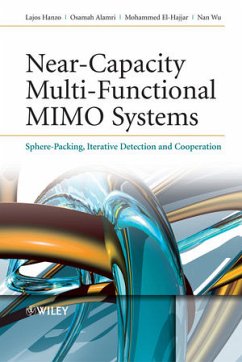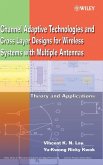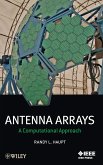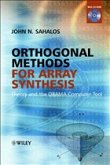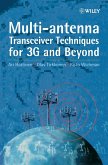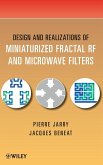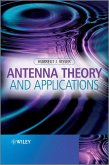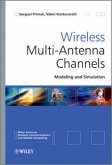Lajos Hanzo, Osamah Alamri, Mohammed El-Hajjar, Nan Wu
Near-Capacity Multi-Functional MIMO Systems
Sphere-Packing, Iterative Detection and Cooperation
Lajos Hanzo, Osamah Alamri, Mohammed El-Hajjar, Nan Wu
Near-Capacity Multi-Functional MIMO Systems
Sphere-Packing, Iterative Detection and Cooperation
- Gebundenes Buch
- Merkliste
- Auf die Merkliste
- Bewerten Bewerten
- Teilen
- Produkt teilen
- Produkterinnerung
- Produkterinnerung
Providing an all-encompassing self-contained treatment of Near-Capacity Multi-Functional MIMO Systems , the book starts by categorizing the family of Multiple-Input Multiple-Output (MIMO) schemes as diversity techniques, multiplexing schemes, multiple access arrangements and beam-forming techniques. Sophisticated coherent and low-complexity non-coherent MIMO receivers dispensing with channel estimation are considered in both classic and cooperation-aided scenarios. It is demonstrated that in the presence of correlated shadow-fading, cooperation-assisted systems may be expected to outperform…mehr
Andere Kunden interessierten sich auch für
![Channel-Adaptive Technologies and Cross-Layer Designs for Wireless Systems with Multiple Antennas Channel-Adaptive Technologies and Cross-Layer Designs for Wireless Systems with Multiple Antennas]() Vincent K N LauChannel-Adaptive Technologies and Cross-Layer Designs for Wireless Systems with Multiple Antennas190,99 €
Vincent K N LauChannel-Adaptive Technologies and Cross-Layer Designs for Wireless Systems with Multiple Antennas190,99 €![Antenna Arrays Antenna Arrays]() Randy L HauptAntenna Arrays176,99 €
Randy L HauptAntenna Arrays176,99 €![Orthogonal Methods for Array Synthesis Orthogonal Methods for Array Synthesis]() John SahalosOrthogonal Methods for Array Synthesis146,99 €
John SahalosOrthogonal Methods for Array Synthesis146,99 €![Multi-antenna Transceiver Techniques for 3G & Beyond Multi-antenna Transceiver Techniques for 3G & Beyond]() Ari HottinenMulti-antenna Transceiver Techniques for 3G & Beyond190,99 €
Ari HottinenMulti-antenna Transceiver Techniques for 3G & Beyond190,99 €![Design and Realizations of Miniaturized Fractal Microwave and RF Filters Design and Realizations of Miniaturized Fractal Microwave and RF Filters]() Pierre JarryDesign and Realizations of Miniaturized Fractal Microwave and RF Filters137,99 €
Pierre JarryDesign and Realizations of Miniaturized Fractal Microwave and RF Filters137,99 €![Antenna Theory and Applications Antenna Theory and Applications]() Hubregt J VisserAntenna Theory and Applications107,99 €
Hubregt J VisserAntenna Theory and Applications107,99 €![Wireless Multi-Antenna Channels Wireless Multi-Antenna Channels]() Serguei PrimakWireless Multi-Antenna Channels142,99 €
Serguei PrimakWireless Multi-Antenna Channels142,99 €-
-
-
Providing an all-encompassing self-contained treatment of Near-Capacity Multi-Functional MIMO Systems , the book starts by categorizing the family of Multiple-Input Multiple-Output (MIMO) schemes as diversity techniques, multiplexing schemes, multiple access arrangements and beam-forming techniques. Sophisticated coherent and low-complexity non-coherent MIMO receivers dispensing with channel estimation are considered in both classic and cooperation-aided scenarios. It is demonstrated that in the presence of correlated shadow-fading, cooperation-assisted systems may be expected to outperform their non-cooperative counterparts. The book contains a 100-page chapter on the unified treatment of all block codes in the context of high-flexibility, cutting-edge irregular Linear Dispersion Codes (LDC), which approach the MIMO-capacity. The majority of the book's solutions are in the optimum sphere-packing frame-work. * Sophisticated amalgam of five year's near-capacity MIMO research * Detailed examination of wireless landscape, including the fields of channel coding, spacetime coding and turbo detection techniques * Novel tool of Extrinsic Information Transfer Charts (EXIT) used to address recent developments * Material presented logically, allowing advanced readers to turn directly to any specific chapter of interest * One of the only books to cover these subjects, giving equal weighting to each
Hinweis: Dieser Artikel kann nur an eine deutsche Lieferadresse ausgeliefert werden.
Hinweis: Dieser Artikel kann nur an eine deutsche Lieferadresse ausgeliefert werden.
Produktdetails
- Produktdetails
- Verlag: John Wiley & Sons / Wiley
- Seitenzahl: 712
- Erscheinungstermin: 1. Juli 2009
- Englisch
- Abmessung: 251mm x 173mm x 30mm
- Gewicht: 907g
- ISBN-13: 9780470779651
- ISBN-10: 0470779659
- Artikelnr.: 26431377
- Herstellerkennzeichnung
- Libri GmbH
- Europaallee 1
- 36244 Bad Hersfeld
- gpsr@libri.de
- Verlag: John Wiley & Sons / Wiley
- Seitenzahl: 712
- Erscheinungstermin: 1. Juli 2009
- Englisch
- Abmessung: 251mm x 173mm x 30mm
- Gewicht: 907g
- ISBN-13: 9780470779651
- ISBN-10: 0470779659
- Artikelnr.: 26431377
- Herstellerkennzeichnung
- Libri GmbH
- Europaallee 1
- 36244 Bad Hersfeld
- gpsr@libri.de
Lajos Hanzo FREng, FIEEE, FIET, DSc received his degree in electronics in 1976 and his doctorate in 1983. During his 31-year career in telecommunications he has held various research and academic posts in Hungary, Germany and the UK. Since 1986 he has been with the School of Electronics and Computer Science, University of Southampton, UK, where he holds the chair in telecommunications. He has co-authored 17 books on mobile radio communications totaling in excess of 10 000 pages, published in excess of 800 research papers, acted as TPC Chair of several IEEE conferences, presented keynote lectures and been awarded a number of distinctions. Currently he is directing an academic research team, working on a range of research projects in the field of wireless multimedia communications sponsored by industry, the Engineering and Physical Sciences Research Council (EPSRC) UK, the European IST Programme and the Mobile Virtual Centre of Excellence (VCE), UK. He is an enthusiastic supporter of industrial and academic liaison and he offers a range of industrial courses. He is also an IEEE Distinguished Lecturer as well as a Governor of both the IEEE ComSoc and the VTS. He is the acting Editor-in-Chief of the IEEE Press. For further information on research in progress and associated publications please refer to http://www-mobile.ecs.soton.ac.uk. Osamah Rashed Alamri received his BS degree with first class honours in electrical engineering from King Fahd University of Petroleum and Minerals (KFUPM), Dhahran, Saudi Arabia, in 1997, where he was ranked first with a 4.0 GPA. In 2002, he received his MS degree in electrical engineering from Stanford University, California, USA. He submitted his PhD thesis in October 2006 and published in excess of 20 research papers while working towards his PhD degree with the Communications Group, School of Electronics and Computer Science, University of Southampton, UK. His research interests include sphere packing modulation, space-time coding, turbo coding and detection, multi-dimensional mapping and MIMO systems. At the time of writing he is continuing his investigations as a post-doctoral researcher. Mohammed El-Hajjar received his BEng degree (with distinction) in electrical engineering from the American University of Beirut (AUB), Lebanon, and his MSc degree (with distinction) in radio frequency communication systems from the University of Southampton, UK. Since October 2005, he has been working towards his PhD degree with the Communications Group, School of Electronics and Computer Science, University of Southampton, UK. He is the recipient of several academic awards from the AUB as well as the University of Southampton. His research interests include sphere packing modulation, space-time coding, differential space-time spreading, adaptive transceiver design and cooperative communications. In 2008 he completed his PhD thesis and joined Ensigma in Chepstow, Wales, UK, as a wireless system architect. Nan Wu received his BEng in electronics engineering in 2003 from Dalian University of Technology, China. He then moved to the UK and received his MSc degree (with distinction) and PhD from the University of Southampton,UK in 2004 and 2008, respectively.His research interests are in the area of wireless communications, including space-time coding, channel coding and cooperative MIMO systems. In September 2008 he joined the National Institute of Standards and Technology (NIST) in the USA as a guest researcher working on cross-layer designs.
About the Authors.
OtherWiley?IEEE Press Books on Related Topics.
Preface.
Acknowledgments.
1 Problem Formulation, Objectives and Benefits.
1.1 TheWireless Channel and the Concept of Diversity.
1.2 Diversity and Multiplexing Trade-offs in Multi-functional MIMO Systems.
1.3 Coherent versus Non-coherent Detection for STBCs Using Co-located and
Cooperative Antenna Elements.
1.4 Historical Perspective and State-of-the-Art Contributions.
1.5 Iterative Detection Schemes and their Convergence Analysis.
1.6 Outline and Novel Aspects of the Monograph.
Part I Coherent Versus Differential Turbo Detection of Sphere-packing-aided
Single-user MIMO Systems.
List of Symbols in Part I.
2 Space-Time Block Code Design using Sphere Packing.
2.1 Introduction.
2.2 Design Criteria for Space-Time Signals.
2.3 Design Criteria for Time-correlated Fading Channels.
2.4 Orthogonal Space-Time Code Design using SP.
2.5 STBC-SP Performance.
2.6 Chapter Conclusions.
2.7 Chapter Summary.
3 Turbo Detection of Channel-coded STBC-SP Schemes.
3.1 Introduction.
3.2 System Overview.
3.3 Iterative Demapping.
3.4 Binary EXIT Chart Analysis.
3.5 Performance of Turbo-detected Bit-based STBC-SP Schemes.
3.6 Chapter Conclusions.
3.7 Chapter Summary.
4 Turbo Detection of Channel-coded DSTBC-SP Schemes.
4.1 Introduction.
4.2 Differential STBC using SP Modulation.
4.3 Bit-based RSC-coded Turbo-detected DSTBC-SP Scheme.
4.4 Chapter Conclusions.
4.5 Chapter Summary.
5 Three-stage Turbo-detected STBC-SP Schemes.
5.1 Introduction.
5.2 System Overview.
5.3 EXIT Chart Analysis.
5.4 Maximum Achievable Bandwidth Efficiency.
5.5 Performance of Three-stageTurbo-detected STBC-SP Schemes.
5.6 Chapter Conclusions.
5.7 Chapter Summary.
6 Symbol-based Channel-coded STBC-SP Schemes.
6.1 Introduction.
6.2 System Overview.
6.3 Symbol-based Iterative Decoding.
6.4 Non-binary EXIT Chart Analysis.
6.5 Performance of Bit-based and Symbol-based LDPC-coded STBC-SP Schemes.
6.6 Chapter Conclusions.
6.7 Chapter Summary.
Part II Coherent Versus Differential Turbo Detection of Single-user and
Cooperative MIMOs.
List of Symbols in Part II.
7 Linear Dispersion Codes: An EXIT Chart Perspective.
7.1 Introduction and Outline.
7.2 Linear Dispersion Codes.
7.3 Link Between STBCs and LDCs.
7.4 EXIT-chart-based Design of LDCs.
7.5 EXIT-chart-based Design of IR-PLDCs.
7.6 Conclusion.
8 Differential Space-Time Block Codes: A Universal Approach.
8.1 Introduction and Outline.
8.2 System Model.
8.3 DOSTBCs.
8.4 DLDCs.
8.5 RSC-coded Precoder-aided DOSTBCs.
8.6 IRCC-coded Precoder-aided DLDCs.
8.7 Conclusion.
9 Cooperative Space-Time Block Codes.
9.1 Introduction and Outline.
9.2 Twin-layer CLDCs.
9.3 IRCC-coded Precoder-aided CLDCs.
9.4 Conclusion.
Part III Differential Turbo Detection of Multi-functional MIMO-aided
Multi-user and Cooperative Systems.
List of Symbols in Part III.
10 Differential Space-Time Spreading.
10.1 Introduction.
10.2 DPSK.
10.3 DSTS Designusing Two Transmit Antennas.
10.4 DSTS Design Using Four Transmit Antennas.
10.5 Chapter Conclusions.
10.6 Chapter Summary.
11 Iterative Detection of Channel-coded DSTS Schemes.
11.1 Introduction.
11.2 Iterative Detection of RSC-coded DSTS Schemes.
11.3 Iterative Detection of RSC-coded and Unity-rate Precoded
Four-antenna-aided DSTS-SP System.
11.4 Chapter Conclusions.
11.5 Chapter Summary.
12 Adaptive DSTS-assisted Iteratively Detected SP Modulation.
12.1 Introduction.
12.2 System Overview.
12.3 Adaptive DSTS-assisted SP Modulation.
12.4 VSF-based Adaptive Rate DSTS.
12.5 Variable-code-rate Iteratively Detected DSTS-SP System.
12.6 Results and Discussion.
12.7 Chapter Conclusion and Summary.
13 Layered Steered Space-Time Codes.
13.1 Introduction.
13.2 LSSTCs.
13.3 Capacity of LSSTCs.
13.4 Iterative Detection and EXIT Chart Analysis.
13.5 Results and Discussion.
13.6 Chapter Conclusions.
13.7 Chapter Summary.
14 DL LSSTS-aided Generalized MC DS-CDMA.
14.1 Introduction.
14.2 LSSTS-aided Generalized MCDS-CDMA.
14.3 Increasing the Number of Users by Employing TD and FD Spreading.
14.4 Iterative Detection and EXIT Chart Analysis.
14.5 Results and Discussion.
14.6 Chapter Conclusions.
14.7 Chapter Summary.
15 Distributed Turbo Coding.
15.1 Introduction.
15.2 Background of Cooperative Communications.
15.3 DTC.
15.4 Results and Discussion.
15.5 Chapter Conclusions.
15.6 Chapter Summary.
16 Conclusions and Future Research.
16.1 Summary and Conclusions.
16.2 Future Research Ideas.
16.3 Closing Remarks.
A Gray Mapping and AGM Schemes for SP Modulation of Size L=16.
B EXIT Charts of Various Bit-based Turbo-detected STBC-SP Schemes.
C EXIT Charts of Various Bit-based Turbo-detected DSTBC-SP Schemes.
D LDCs? ÷ for QPSK Modulation.
E DLDCs? ÷ for 2PAM Modulation.
F CLDCs? ÷1 and ÷2 for BPSK Modulation.
G Weighting Coefficient Vectors ë and ã.
H Gray Mapping and AGM Schemes for SP Modulation of Size L=16.
Glossary.
Bibliography.
Index.
Author Index.
OtherWiley?IEEE Press Books on Related Topics.
Preface.
Acknowledgments.
1 Problem Formulation, Objectives and Benefits.
1.1 TheWireless Channel and the Concept of Diversity.
1.2 Diversity and Multiplexing Trade-offs in Multi-functional MIMO Systems.
1.3 Coherent versus Non-coherent Detection for STBCs Using Co-located and
Cooperative Antenna Elements.
1.4 Historical Perspective and State-of-the-Art Contributions.
1.5 Iterative Detection Schemes and their Convergence Analysis.
1.6 Outline and Novel Aspects of the Monograph.
Part I Coherent Versus Differential Turbo Detection of Sphere-packing-aided
Single-user MIMO Systems.
List of Symbols in Part I.
2 Space-Time Block Code Design using Sphere Packing.
2.1 Introduction.
2.2 Design Criteria for Space-Time Signals.
2.3 Design Criteria for Time-correlated Fading Channels.
2.4 Orthogonal Space-Time Code Design using SP.
2.5 STBC-SP Performance.
2.6 Chapter Conclusions.
2.7 Chapter Summary.
3 Turbo Detection of Channel-coded STBC-SP Schemes.
3.1 Introduction.
3.2 System Overview.
3.3 Iterative Demapping.
3.4 Binary EXIT Chart Analysis.
3.5 Performance of Turbo-detected Bit-based STBC-SP Schemes.
3.6 Chapter Conclusions.
3.7 Chapter Summary.
4 Turbo Detection of Channel-coded DSTBC-SP Schemes.
4.1 Introduction.
4.2 Differential STBC using SP Modulation.
4.3 Bit-based RSC-coded Turbo-detected DSTBC-SP Scheme.
4.4 Chapter Conclusions.
4.5 Chapter Summary.
5 Three-stage Turbo-detected STBC-SP Schemes.
5.1 Introduction.
5.2 System Overview.
5.3 EXIT Chart Analysis.
5.4 Maximum Achievable Bandwidth Efficiency.
5.5 Performance of Three-stageTurbo-detected STBC-SP Schemes.
5.6 Chapter Conclusions.
5.7 Chapter Summary.
6 Symbol-based Channel-coded STBC-SP Schemes.
6.1 Introduction.
6.2 System Overview.
6.3 Symbol-based Iterative Decoding.
6.4 Non-binary EXIT Chart Analysis.
6.5 Performance of Bit-based and Symbol-based LDPC-coded STBC-SP Schemes.
6.6 Chapter Conclusions.
6.7 Chapter Summary.
Part II Coherent Versus Differential Turbo Detection of Single-user and
Cooperative MIMOs.
List of Symbols in Part II.
7 Linear Dispersion Codes: An EXIT Chart Perspective.
7.1 Introduction and Outline.
7.2 Linear Dispersion Codes.
7.3 Link Between STBCs and LDCs.
7.4 EXIT-chart-based Design of LDCs.
7.5 EXIT-chart-based Design of IR-PLDCs.
7.6 Conclusion.
8 Differential Space-Time Block Codes: A Universal Approach.
8.1 Introduction and Outline.
8.2 System Model.
8.3 DOSTBCs.
8.4 DLDCs.
8.5 RSC-coded Precoder-aided DOSTBCs.
8.6 IRCC-coded Precoder-aided DLDCs.
8.7 Conclusion.
9 Cooperative Space-Time Block Codes.
9.1 Introduction and Outline.
9.2 Twin-layer CLDCs.
9.3 IRCC-coded Precoder-aided CLDCs.
9.4 Conclusion.
Part III Differential Turbo Detection of Multi-functional MIMO-aided
Multi-user and Cooperative Systems.
List of Symbols in Part III.
10 Differential Space-Time Spreading.
10.1 Introduction.
10.2 DPSK.
10.3 DSTS Designusing Two Transmit Antennas.
10.4 DSTS Design Using Four Transmit Antennas.
10.5 Chapter Conclusions.
10.6 Chapter Summary.
11 Iterative Detection of Channel-coded DSTS Schemes.
11.1 Introduction.
11.2 Iterative Detection of RSC-coded DSTS Schemes.
11.3 Iterative Detection of RSC-coded and Unity-rate Precoded
Four-antenna-aided DSTS-SP System.
11.4 Chapter Conclusions.
11.5 Chapter Summary.
12 Adaptive DSTS-assisted Iteratively Detected SP Modulation.
12.1 Introduction.
12.2 System Overview.
12.3 Adaptive DSTS-assisted SP Modulation.
12.4 VSF-based Adaptive Rate DSTS.
12.5 Variable-code-rate Iteratively Detected DSTS-SP System.
12.6 Results and Discussion.
12.7 Chapter Conclusion and Summary.
13 Layered Steered Space-Time Codes.
13.1 Introduction.
13.2 LSSTCs.
13.3 Capacity of LSSTCs.
13.4 Iterative Detection and EXIT Chart Analysis.
13.5 Results and Discussion.
13.6 Chapter Conclusions.
13.7 Chapter Summary.
14 DL LSSTS-aided Generalized MC DS-CDMA.
14.1 Introduction.
14.2 LSSTS-aided Generalized MCDS-CDMA.
14.3 Increasing the Number of Users by Employing TD and FD Spreading.
14.4 Iterative Detection and EXIT Chart Analysis.
14.5 Results and Discussion.
14.6 Chapter Conclusions.
14.7 Chapter Summary.
15 Distributed Turbo Coding.
15.1 Introduction.
15.2 Background of Cooperative Communications.
15.3 DTC.
15.4 Results and Discussion.
15.5 Chapter Conclusions.
15.6 Chapter Summary.
16 Conclusions and Future Research.
16.1 Summary and Conclusions.
16.2 Future Research Ideas.
16.3 Closing Remarks.
A Gray Mapping and AGM Schemes for SP Modulation of Size L=16.
B EXIT Charts of Various Bit-based Turbo-detected STBC-SP Schemes.
C EXIT Charts of Various Bit-based Turbo-detected DSTBC-SP Schemes.
D LDCs? ÷ for QPSK Modulation.
E DLDCs? ÷ for 2PAM Modulation.
F CLDCs? ÷1 and ÷2 for BPSK Modulation.
G Weighting Coefficient Vectors ë and ã.
H Gray Mapping and AGM Schemes for SP Modulation of Size L=16.
Glossary.
Bibliography.
Index.
Author Index.
About the Authors.
OtherWiley?IEEE Press Books on Related Topics.
Preface.
Acknowledgments.
1 Problem Formulation, Objectives and Benefits.
1.1 TheWireless Channel and the Concept of Diversity.
1.2 Diversity and Multiplexing Trade-offs in Multi-functional MIMO Systems.
1.3 Coherent versus Non-coherent Detection for STBCs Using Co-located and
Cooperative Antenna Elements.
1.4 Historical Perspective and State-of-the-Art Contributions.
1.5 Iterative Detection Schemes and their Convergence Analysis.
1.6 Outline and Novel Aspects of the Monograph.
Part I Coherent Versus Differential Turbo Detection of Sphere-packing-aided
Single-user MIMO Systems.
List of Symbols in Part I.
2 Space-Time Block Code Design using Sphere Packing.
2.1 Introduction.
2.2 Design Criteria for Space-Time Signals.
2.3 Design Criteria for Time-correlated Fading Channels.
2.4 Orthogonal Space-Time Code Design using SP.
2.5 STBC-SP Performance.
2.6 Chapter Conclusions.
2.7 Chapter Summary.
3 Turbo Detection of Channel-coded STBC-SP Schemes.
3.1 Introduction.
3.2 System Overview.
3.3 Iterative Demapping.
3.4 Binary EXIT Chart Analysis.
3.5 Performance of Turbo-detected Bit-based STBC-SP Schemes.
3.6 Chapter Conclusions.
3.7 Chapter Summary.
4 Turbo Detection of Channel-coded DSTBC-SP Schemes.
4.1 Introduction.
4.2 Differential STBC using SP Modulation.
4.3 Bit-based RSC-coded Turbo-detected DSTBC-SP Scheme.
4.4 Chapter Conclusions.
4.5 Chapter Summary.
5 Three-stage Turbo-detected STBC-SP Schemes.
5.1 Introduction.
5.2 System Overview.
5.3 EXIT Chart Analysis.
5.4 Maximum Achievable Bandwidth Efficiency.
5.5 Performance of Three-stageTurbo-detected STBC-SP Schemes.
5.6 Chapter Conclusions.
5.7 Chapter Summary.
6 Symbol-based Channel-coded STBC-SP Schemes.
6.1 Introduction.
6.2 System Overview.
6.3 Symbol-based Iterative Decoding.
6.4 Non-binary EXIT Chart Analysis.
6.5 Performance of Bit-based and Symbol-based LDPC-coded STBC-SP Schemes.
6.6 Chapter Conclusions.
6.7 Chapter Summary.
Part II Coherent Versus Differential Turbo Detection of Single-user and
Cooperative MIMOs.
List of Symbols in Part II.
7 Linear Dispersion Codes: An EXIT Chart Perspective.
7.1 Introduction and Outline.
7.2 Linear Dispersion Codes.
7.3 Link Between STBCs and LDCs.
7.4 EXIT-chart-based Design of LDCs.
7.5 EXIT-chart-based Design of IR-PLDCs.
7.6 Conclusion.
8 Differential Space-Time Block Codes: A Universal Approach.
8.1 Introduction and Outline.
8.2 System Model.
8.3 DOSTBCs.
8.4 DLDCs.
8.5 RSC-coded Precoder-aided DOSTBCs.
8.6 IRCC-coded Precoder-aided DLDCs.
8.7 Conclusion.
9 Cooperative Space-Time Block Codes.
9.1 Introduction and Outline.
9.2 Twin-layer CLDCs.
9.3 IRCC-coded Precoder-aided CLDCs.
9.4 Conclusion.
Part III Differential Turbo Detection of Multi-functional MIMO-aided
Multi-user and Cooperative Systems.
List of Symbols in Part III.
10 Differential Space-Time Spreading.
10.1 Introduction.
10.2 DPSK.
10.3 DSTS Designusing Two Transmit Antennas.
10.4 DSTS Design Using Four Transmit Antennas.
10.5 Chapter Conclusions.
10.6 Chapter Summary.
11 Iterative Detection of Channel-coded DSTS Schemes.
11.1 Introduction.
11.2 Iterative Detection of RSC-coded DSTS Schemes.
11.3 Iterative Detection of RSC-coded and Unity-rate Precoded
Four-antenna-aided DSTS-SP System.
11.4 Chapter Conclusions.
11.5 Chapter Summary.
12 Adaptive DSTS-assisted Iteratively Detected SP Modulation.
12.1 Introduction.
12.2 System Overview.
12.3 Adaptive DSTS-assisted SP Modulation.
12.4 VSF-based Adaptive Rate DSTS.
12.5 Variable-code-rate Iteratively Detected DSTS-SP System.
12.6 Results and Discussion.
12.7 Chapter Conclusion and Summary.
13 Layered Steered Space-Time Codes.
13.1 Introduction.
13.2 LSSTCs.
13.3 Capacity of LSSTCs.
13.4 Iterative Detection and EXIT Chart Analysis.
13.5 Results and Discussion.
13.6 Chapter Conclusions.
13.7 Chapter Summary.
14 DL LSSTS-aided Generalized MC DS-CDMA.
14.1 Introduction.
14.2 LSSTS-aided Generalized MCDS-CDMA.
14.3 Increasing the Number of Users by Employing TD and FD Spreading.
14.4 Iterative Detection and EXIT Chart Analysis.
14.5 Results and Discussion.
14.6 Chapter Conclusions.
14.7 Chapter Summary.
15 Distributed Turbo Coding.
15.1 Introduction.
15.2 Background of Cooperative Communications.
15.3 DTC.
15.4 Results and Discussion.
15.5 Chapter Conclusions.
15.6 Chapter Summary.
16 Conclusions and Future Research.
16.1 Summary and Conclusions.
16.2 Future Research Ideas.
16.3 Closing Remarks.
A Gray Mapping and AGM Schemes for SP Modulation of Size L=16.
B EXIT Charts of Various Bit-based Turbo-detected STBC-SP Schemes.
C EXIT Charts of Various Bit-based Turbo-detected DSTBC-SP Schemes.
D LDCs? ÷ for QPSK Modulation.
E DLDCs? ÷ for 2PAM Modulation.
F CLDCs? ÷1 and ÷2 for BPSK Modulation.
G Weighting Coefficient Vectors ë and ã.
H Gray Mapping and AGM Schemes for SP Modulation of Size L=16.
Glossary.
Bibliography.
Index.
Author Index.
OtherWiley?IEEE Press Books on Related Topics.
Preface.
Acknowledgments.
1 Problem Formulation, Objectives and Benefits.
1.1 TheWireless Channel and the Concept of Diversity.
1.2 Diversity and Multiplexing Trade-offs in Multi-functional MIMO Systems.
1.3 Coherent versus Non-coherent Detection for STBCs Using Co-located and
Cooperative Antenna Elements.
1.4 Historical Perspective and State-of-the-Art Contributions.
1.5 Iterative Detection Schemes and their Convergence Analysis.
1.6 Outline and Novel Aspects of the Monograph.
Part I Coherent Versus Differential Turbo Detection of Sphere-packing-aided
Single-user MIMO Systems.
List of Symbols in Part I.
2 Space-Time Block Code Design using Sphere Packing.
2.1 Introduction.
2.2 Design Criteria for Space-Time Signals.
2.3 Design Criteria for Time-correlated Fading Channels.
2.4 Orthogonal Space-Time Code Design using SP.
2.5 STBC-SP Performance.
2.6 Chapter Conclusions.
2.7 Chapter Summary.
3 Turbo Detection of Channel-coded STBC-SP Schemes.
3.1 Introduction.
3.2 System Overview.
3.3 Iterative Demapping.
3.4 Binary EXIT Chart Analysis.
3.5 Performance of Turbo-detected Bit-based STBC-SP Schemes.
3.6 Chapter Conclusions.
3.7 Chapter Summary.
4 Turbo Detection of Channel-coded DSTBC-SP Schemes.
4.1 Introduction.
4.2 Differential STBC using SP Modulation.
4.3 Bit-based RSC-coded Turbo-detected DSTBC-SP Scheme.
4.4 Chapter Conclusions.
4.5 Chapter Summary.
5 Three-stage Turbo-detected STBC-SP Schemes.
5.1 Introduction.
5.2 System Overview.
5.3 EXIT Chart Analysis.
5.4 Maximum Achievable Bandwidth Efficiency.
5.5 Performance of Three-stageTurbo-detected STBC-SP Schemes.
5.6 Chapter Conclusions.
5.7 Chapter Summary.
6 Symbol-based Channel-coded STBC-SP Schemes.
6.1 Introduction.
6.2 System Overview.
6.3 Symbol-based Iterative Decoding.
6.4 Non-binary EXIT Chart Analysis.
6.5 Performance of Bit-based and Symbol-based LDPC-coded STBC-SP Schemes.
6.6 Chapter Conclusions.
6.7 Chapter Summary.
Part II Coherent Versus Differential Turbo Detection of Single-user and
Cooperative MIMOs.
List of Symbols in Part II.
7 Linear Dispersion Codes: An EXIT Chart Perspective.
7.1 Introduction and Outline.
7.2 Linear Dispersion Codes.
7.3 Link Between STBCs and LDCs.
7.4 EXIT-chart-based Design of LDCs.
7.5 EXIT-chart-based Design of IR-PLDCs.
7.6 Conclusion.
8 Differential Space-Time Block Codes: A Universal Approach.
8.1 Introduction and Outline.
8.2 System Model.
8.3 DOSTBCs.
8.4 DLDCs.
8.5 RSC-coded Precoder-aided DOSTBCs.
8.6 IRCC-coded Precoder-aided DLDCs.
8.7 Conclusion.
9 Cooperative Space-Time Block Codes.
9.1 Introduction and Outline.
9.2 Twin-layer CLDCs.
9.3 IRCC-coded Precoder-aided CLDCs.
9.4 Conclusion.
Part III Differential Turbo Detection of Multi-functional MIMO-aided
Multi-user and Cooperative Systems.
List of Symbols in Part III.
10 Differential Space-Time Spreading.
10.1 Introduction.
10.2 DPSK.
10.3 DSTS Designusing Two Transmit Antennas.
10.4 DSTS Design Using Four Transmit Antennas.
10.5 Chapter Conclusions.
10.6 Chapter Summary.
11 Iterative Detection of Channel-coded DSTS Schemes.
11.1 Introduction.
11.2 Iterative Detection of RSC-coded DSTS Schemes.
11.3 Iterative Detection of RSC-coded and Unity-rate Precoded
Four-antenna-aided DSTS-SP System.
11.4 Chapter Conclusions.
11.5 Chapter Summary.
12 Adaptive DSTS-assisted Iteratively Detected SP Modulation.
12.1 Introduction.
12.2 System Overview.
12.3 Adaptive DSTS-assisted SP Modulation.
12.4 VSF-based Adaptive Rate DSTS.
12.5 Variable-code-rate Iteratively Detected DSTS-SP System.
12.6 Results and Discussion.
12.7 Chapter Conclusion and Summary.
13 Layered Steered Space-Time Codes.
13.1 Introduction.
13.2 LSSTCs.
13.3 Capacity of LSSTCs.
13.4 Iterative Detection and EXIT Chart Analysis.
13.5 Results and Discussion.
13.6 Chapter Conclusions.
13.7 Chapter Summary.
14 DL LSSTS-aided Generalized MC DS-CDMA.
14.1 Introduction.
14.2 LSSTS-aided Generalized MCDS-CDMA.
14.3 Increasing the Number of Users by Employing TD and FD Spreading.
14.4 Iterative Detection and EXIT Chart Analysis.
14.5 Results and Discussion.
14.6 Chapter Conclusions.
14.7 Chapter Summary.
15 Distributed Turbo Coding.
15.1 Introduction.
15.2 Background of Cooperative Communications.
15.3 DTC.
15.4 Results and Discussion.
15.5 Chapter Conclusions.
15.6 Chapter Summary.
16 Conclusions and Future Research.
16.1 Summary and Conclusions.
16.2 Future Research Ideas.
16.3 Closing Remarks.
A Gray Mapping and AGM Schemes for SP Modulation of Size L=16.
B EXIT Charts of Various Bit-based Turbo-detected STBC-SP Schemes.
C EXIT Charts of Various Bit-based Turbo-detected DSTBC-SP Schemes.
D LDCs? ÷ for QPSK Modulation.
E DLDCs? ÷ for 2PAM Modulation.
F CLDCs? ÷1 and ÷2 for BPSK Modulation.
G Weighting Coefficient Vectors ë and ã.
H Gray Mapping and AGM Schemes for SP Modulation of Size L=16.
Glossary.
Bibliography.
Index.
Author Index.

